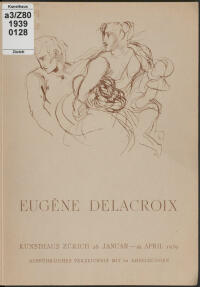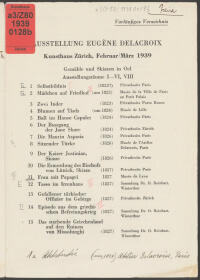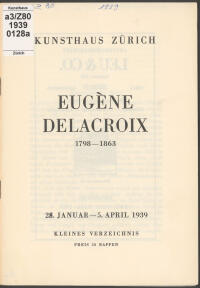Eugène Delacroix
28.01.1939 – 16.04.1939
Location Kunsthaus.
Location Kunsthaus.
Master of Composition, Colour and Light
The exhibition devoted to Eugène Delacroix (b. 1798 Charenton-Saint-Maurice, d. 1863 Paris) in the Kunsthaus Zurich, which brought together about eighty paintings and many works on paper, came about due to the support of the Swiss painter resident in France, Charles Montag. Just a few months before World War II broke out, the Director of the Kunsthaus, Wilhelm Wartmann had complained rather cryptically about the ‘difficulties of our times,’ which unfortunately hindered the international exchange of artworks. But the honorary committee, including no fewer than two federal MPs, resembled a conspiracy of Franco-Swiss friendship, and so it was possible, despite the difficulties, to bring the great French painter into Switzerland.
The exhibition was based on one in Paris during 1930 and followed on from the Kunsthaus exhibitions of Jean-Baptiste Camille Corot (1934) and Jean Désiré Gustave Courbet (1936). In the catalogue, Eugène Delacroix was described as a solitary artist who surpassed his teachers: ‘He created for himself a new, individual voice according to sound, rhythm, and internal laws.’ In the paintings of the mature, roughly fifty-year-old artist, as the text continues, ‘the colours blend more and more purely in silent fire.’ The oneness of image and paint was transfigured into absolute beauty, just as studies and the final picture drew closer together, wrote the Kunsthaus Director in almost lyrical-seeming words in the introduction to the catalogue. And so, it is very understandable that Impressionists and Cubists constantly referred to the resistant artist, whose work was seen as trailblazing for later developments.
The exhibition was very well received. For the reviewer in the Weltwoche, saw as highlights ‘Tobias and the Angel’ (1862, Reinhart Collection, Winterthur) and ‘Romeo and Juliet’ (1845, private collection, Basel) as well as ‘Ovid in the Land of the Scythians’ (1862, private collection, Zürich). The composition, the bodily and material, coupled with narrative talent, taste, culture and poetic power – these determined the mastership of Delacroix. The exhibition provided an ‘incomparable’ opportunity to cast an eye into the workshop of a great artist and thus experience the ‘miracle of colour in the work of a master’ was the Tages-Anzeiger’s assessment.
[Peter Stohler]
Further information
Just a few months before World War II broke out, the Director of the Kunsthaus, Wilhelm Wartmann had complained rather cryptically about the ‘difficulties of our times,’ which unfortunately hindered the international exchange of artworks. But the honorary committee, including no fewer than two federal MPs, resembled a conspiracy of Franco-Swiss friendship, and so it was possible, despite the difficulties, to bring the great French painter into Switzerland.
78 days
1 Artist
1 Artist

1/3
exhibition catalog

2/3
exhibition catalog

3/3
exhibition catalog
1/3